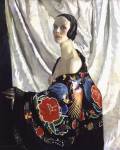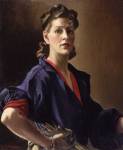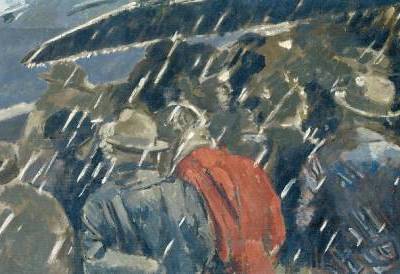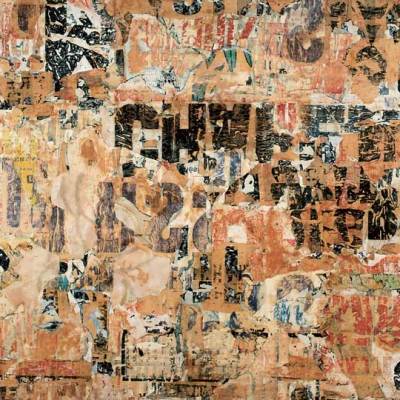Self-portraiture has become an everyday activity. We use our camera phones to document what we are doing, where we are and who we are with, and we include our own grinning mug in the picture to authenticate and take possession of the experience. We then publicise the image via social media and anxiously wait for validation and reassurance from our friends and followers.
Looking at Anthony van Dyck’s bravura self-portrait at Turner Contemporary, Margate, I wonder whether he would have been concerned with how many ‘likes’ he was going to get. His last self-portrait, he looks here like a man in no doubt about his talent and celebrity, comfortable in his own self-scrutiny. But there’s the rub: how much do we trust the honesty of Van Dyck’s self-examination, and how much of this is social performance?
Self-Portrait (1640–1), Anthony van Dyck © Philip Mould & Co

Click here for a gallery of highlights from the exhibition
This is a question that recurs throughout the current exhibition at Turner Contemporary. ‘Self: Image and identity – self-portraiture from Van Dyck to Louise Bourgeois’ brings together over 100 self-portraits, mainly by British artists and mainly drawn from the National Portrait Gallery’s collection. The historical range is greater than the title would suggest: it starts with a curious double portrait by Gerlach Flicke from 1554, the earliest known oil self-portrait in Britain, and ends with a newly commissioned work, Sound System Self-Portrait, by Jason Evans.
The works in the exhibition are as diverse as these two extremes would indicate, and apart from all being self-portraits, they do not fall easily into categories or themes. Some emulate the swagger of Van Dyck, others are self-deprecating. J.M.W. Turner’s tiny watercolour self-portrait, painted at around the age of 15, captures an expression of wide-eyed adolescent intensity. Gainsborough’s is understated and business-like.
 Female artists are unusually well represented in this throng. A deliberate strategy by the curators, it prompts a more critical questioning of the way identities are represented and offers some alternatives to the macho posturing and attention-seeking going on alongside.
Female artists are unusually well represented in this throng. A deliberate strategy by the curators, it prompts a more critical questioning of the way identities are represented and offers some alternatives to the macho posturing and attention-seeking going on alongside.
In her self-portrait of c. 1665, Mary Beale has hung up her palette on the wall but holds up a painting of her two sons, an allusion to a different kind of creativity. In contrast, Angelica Kauffmann takes up the attributes of her profession, her pen and portfolio, but at the same time seems tentative and guarded.
Two portraits of the sisters Anna Katrina and Doris Zinkeisen show contrasting aspects of feminine social identity. For Doris, it is all about style and cool aloofness in her 1929 self-portrait. Her shawl, with its exotic flowers and birds-of-paradise design, acts as a screen, betraying the defensive quality of her fashionable display. Anna Katrina, on the other hand, adopts a persona of wartime emancipation in her self-portrait from c. 1944. Hair tied back, sleeves of her overalls rolled up and a muscular forearm clutching her paint brushes, she is robust, dynamic and assertive.
The credibility of female role-playing is questioned by Trish Morrissey in a series of photographs called Front (2005–7). In these images she imposes herself in other people’s seaside snaps, taking the place of the wife or the mother in family groups on the beach, to the extent of even adopting the names and wearing the clothes of her alter-egos. The displaced subject then becomes the photographer. Morrissey has a chameleon-like identity in these photographs, which negates both her own individuality and her role as the artist.
By now we are a long way from the poise and confidence of Van Dyck. Image provides a way of investigating identity, of creating fictionalised or even impossible selves. In her 2007 self-portrait, Louise Bourgeois describes herself as a five-legged cat, with a wry smile on her face.
 And we are also a long way from the ‘selfies’ of social media. The artist self-portrait is a much more deliberate, more experimental expression of identity. The tussle it embodies between honesty and artifice is the stuff of art. But what this insightful exhibition reveals is that behind the bravado there is also anxiety. And it is an anxiety that all self-portraiture shares, about the inevitable discrepancy between how we imagine ourselves and how we would like others to see us.
And we are also a long way from the ‘selfies’ of social media. The artist self-portrait is a much more deliberate, more experimental expression of identity. The tussle it embodies between honesty and artifice is the stuff of art. But what this insightful exhibition reveals is that behind the bravado there is also anxiety. And it is an anxiety that all self-portraiture shares, about the inevitable discrepancy between how we imagine ourselves and how we would like others to see us.
‘Self: Image and identity – self-portraiture from Van Dyck to Louise Bourgeois’ is at Turner Contemporary, Margate, until 10 May.
Related Articles
First Look: ‘Self’ at Turner Contemporary (Sarah Martin)
Restrain your selfie: a defence of the self-portrait (Maggie Gray)
£10 million raised to keep Van Dyck’s last self-portrait in the UK





